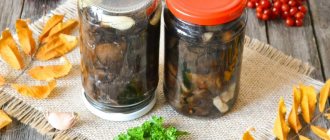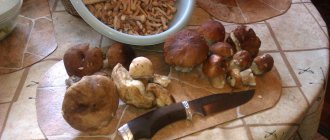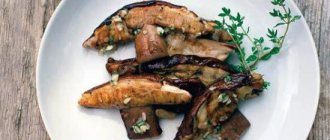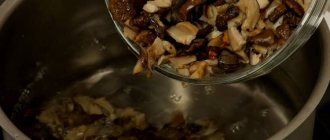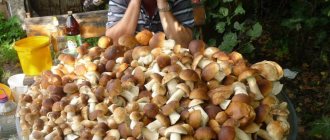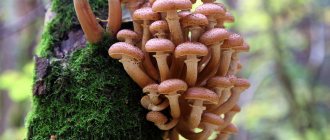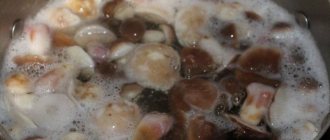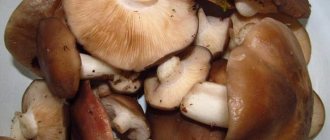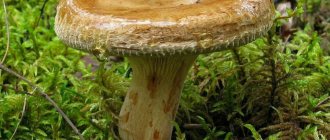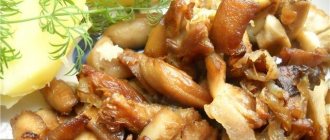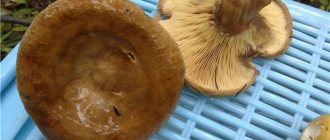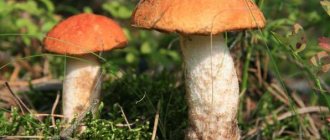Svinushki are lamellar mushrooms that belong to the Svinushka family. People call them cowsheds, dunka, pigs, pigs. This family includes several species, not all of which can be used as food. Therefore, in order not to harm your health, you need to know their distinctive signs.
Svinushki are lamellar mushrooms that belong to the Svinushka family.
Svinushki are mushrooms with small fleshy and thick caps from 10 to 20 cm in diameter. At an early age they are convex, and as they grow, they usually become smooth and then funnel-shaped. The edges of adult mushrooms are often wavy and everted. Depending on the type, the color of the caps can vary from light green to grayish-brown, and the surface is velvety, rough or smooth. The dense pulp, from light yellow to brown in color, can be either soft or quite hard. When cut or simply pressed, it usually begins to darken. Pigs are characterized by rather small legs with a diameter of up to 5 cm and a height of up to 10 cm; they can be either smooth or pubescent; their color usually matches the cap. In some species they are completely absent.
Pigs most often grow in damp places of deciduous or coniferous forests,
sometimes they can be found in meadows or marshy banks of water bodies. Most of all they like to settle near birch or oak trees. Pigs, as a rule, grow in groups; single specimens are rare. Fruiting begins in mid-summer and ends by the end of autumn. During particularly wet periods, these mushrooms produce very abundant harvests. Some species of pigs settle on dead trees and even on the walls of wooden houses, destroying them.
Description of types of pigs
Currently, 10 types of pigs are known, all of them contain substances harmful to the body, in varying quantities. Some of them are poisonous mushrooms.
Thick pig (felt)
Tapinella atrotomentosa has a fleshy, velvety cap of pistachio, reddish-brown or brown color. Over time, its convex shape changes to a concave one. The diameter of the cap ranges from 15 to 20 cm. This mushroom is characterized by thick, hard yellowish flesh and thin, frequently spaced cream-colored plates. The fleshy, dense leg is characterized by a pubescent surface of black-brown or brown color. Its diameter reaches 5 cm and its length is 10 cm. The fat pig has practically no smell and has a bitter taste. When pressed, all parts of the mushroom become brown in color.
Today this species is considered conditionally edible.
Thick pig (felt)
Thin pig
Paxillus involutus is characterized by a slightly convex or flat cap from grayish-olive to reddish-brown in color. Its surface is velvety, and the shaggy edges are tightly curled. The yellowish, soft and loose pulp has no smell or taste. The lamellar layer consists of reddish-yellow wide and sparse plates. They can be connected by peculiar membranes, forming a mesh surface. Full legs have a diameter of 1 to 2 cm and a height of up to 9 cm. This species is poisonous.
Thin pig
Pig ear-shaped (panus-shaped)
Tapinella panuoides has a thick, rather hard cap that grows up to 12 cm in diameter. Its surface can be velvety or smooth, and its shape resembles a fan or shell. The edges are usually jagged, jagged, or wavy. The color of the mushroom ranges from yellowish-brown to dark red. The ear-shaped pig is characterized by pulp of a rubbery consistency of a yellowish-cream or light brown hue, which becomes brown when cut. The leg of this species is very short, and most often completely absent. This mushroom can be recognized by its pleasant pine aroma. It is classified as a conditionally edible species.
The benefits and harms of pigs
Although many mushroom pickers consider pig mushrooms to be very tasty and nutritious mushrooms, it is difficult to talk about their benefits. And they can cause significant harm to the body. They contain a large amount of muscarine, a toxic substance that does not break down under any method of processing and is not removed from the body, gradually poisoning it. In addition, they contain antigens that force the human body to produce antibodies in the blood. As they accumulate, they lead to the development of serious diseases.
Also, pigs are characterized by active absorption of various chemical compounds, radioisotopes and heavy metals, including lead. Therefore, it is impossible to collect these mushrooms near roads, industrial enterprises and other polluted places.
In connection with the above, we can conclude that if you want to eat pigs, you should do this very rarely, while carefully processing them and, of course, choosing only conditionally edible, and not poisonous, species and environmentally friendly collection sites.
Although many mushroom pickers consider pig mushrooms to be very tasty and nutritious mushrooms, it is difficult to talk about their benefits
Svinushki: to eat or not to eat
Despite the fact that their sale has been officially banned since 1981, the volume of their consumption has not decreased. In Russia, they eat svinushki no less than other mushrooms. There are different types of pigs: they are pickled, salted, fried, and even made into soup. They are sweetish and very pleasant to the taste. Many people refuse to believe that these mushrooms are poisonous. However, pigs contain toxins that are not destroyed by cooking. With their frequent use, antibodies are formed in the human body, which suppress the immune system and destroy red blood cells. All this can lead to kidney failure. The accumulation of antibodies occurs gradually and depends on the characteristics of the organism. And whether it is possible to eat pigs is a personal decision for everyone.
About the edibility of pig mushrooms
In order for eating pigs to cause as little harm to the body as possible, you need to know how to properly prepare them for consumption. The following processing method is recommended:
- Mushrooms should be peeled immediately after picking;
- peeled mushrooms should be soaked for a day in water with the addition of a small amount of salt and citric acid. This will help remove radioisotopes and heavy metal salts. The water needs to be changed several times;
- Rinse the soaked mushrooms well and boil in salted water for 5 minutes, discard the water. Then boil them in clean water two more times for half an hour and wash again;
- cooled mushrooms can be fried, stewed, salted, marinated, added to salads, fillings for pies and dumplings and other dishes.
Pigs are characterized by active absorption of various chemical compounds, radioisotopes and heavy metals, including lead
Marinated pigs
According to reviews from mushroom lovers, salted and pickled pigs are a very tasty preparation.
Ingredients:
- pork (boiled) – 2 kg;
- water – 1 l;
- vinegar - 2 tbsp. l;
- salt – 1 tbsp. l;
- sugar – 1 tbsp. l;
- bay leaf – 5 pcs;
- pepper (allspice) – 15 pcs;
- garlic - 3 cloves.
How to cook:
Boil water, add salt, sugar, spices and mushrooms cut into small pieces, pour in vinegar. Cook for about 20 minutes;
- Wash and sterilize containers with a volume of 1 liter;
- Place the mushrooms in containers, pour marinade over them and add 2 tbsp to each. l olive oil;
- Sterilize jars with mushrooms for 20 minutes and can be closed with tin lids;
- Cooled pieces should be sent to the cellar for storage.
In order for eating pigs to cause as little harm to the body as possible, you need to know how to properly prepare them for consumption.
Salted pork in oil
Ingredients:
- pork (boiled) – 1 kg;
- olive oil – 200 ml;
- salt – 100 g;
- garlic – 3 cloves;
- bay leaf – 5 pcs;
- pepper (allspice) – 15 pcs.
Cooking method:
- Cut the mushrooms into thick strips;
- Heat vegetable oil in a deep frying pan;
- Fry the mushrooms over low heat for an hour;
- Sterilize the jars, place the prepared mushrooms in them, pour hot vegetable oil on top and close with plastic lids;
- It is recommended to store cooled preparations in the refrigerator.
Marinated mushrooms
Marinated pigs are a delicious delicacy. These mushrooms take longer to cook than others. It is important to know how to cook pork correctly so that the dish turns out tender and flavorful. For this you need the following products:
- pigs - 3 kg;
- vinegar - 30 grams;
- sugar - 30 g;
- salt - 30 g;
- cloves - 10 pcs.;
- black pepper - 5 peas;
- bay leaf - 5 sheets;
- garlic;
- dill.
The mushrooms are soaked for 3 hours, then washed well and cut into pieces. After this, they are boiled in highly salted water for half an hour. Next, the brine is drained, and the boiled mushrooms must be washed in 5 waters. After this, they are boiled again in heavily salted water for another 30 minutes. It is very important to take into account the time and monitor how long to cook the pig mushrooms. Then they are washed again and filled with cold water for another 1 hour. At this time, it is necessary to prepare the marinade. For it, water, salt, sugar, vinegar, spices are mixed and heated so that all the crystals dissolve. The pigs are cooked in this marinade for 10-15 minutes. At the end, the garlic and herbs crumble. After this, the mushrooms can be rolled into jars.
Edible mushrooms that pigs are confused with
In appearance, a young plump mushroom can be confused with a Polish mushroom or a green flywheel, but they have a tubular layer. The eared pig sometimes resembles saffron milk caps or chanterelles.
As you can see, some types of pig mushrooms are quite tasty, but low-quality mushrooms. Therefore, you should be very careful when collecting and preparing them. Also, you should not get carried away with their use, as this can lead not only to poisoning, but also to the development of stroke, varicose veins and other serious ailments. And, of course, before you start collecting them, you should study which species are poisonous and which are conditionally edible.
Post Views: 458
The description of the mushroom, which, in addition to the official Paxillus involutus, has such popular names as cow tongue, pig, pig, solokha, dunka and cowshed, is as follows:
- the diameter of the cap of an adult mushroom most often varies between 10-12 cm, but some specimens have caps with a diameter of 15-18 cm;
- fleshy type cap;
- in young fruiting bodies the cap has a slightly convex shape and rolled felt edges;
- adult fruiting bodies have a flat, funnel-shaped, depressed or funnel-type cap;
- the edges of the cap can be drooping, frilled, ribbed, straight or wavy;
- young specimens are characterized by an olive-brown or olive-brownish coloring of the cap;
- adult mushrooms have a grayish-brown or brown cap that darkens when cut or pressed;
- the surface of the cap is dry, with fibrous pubescence;
- mushroom pulp is dense, but soft, and with age acquires a characteristic looseness;
- during the dry period, worminess of the pulp and legs is observed;
- characterized by the absence of a pronounced mushroom aroma and taste;
- a fairly short leg of a solid type with a matte and smooth surface of ocher-olive or dirty yellow color.
You can most often find entire groups of small pigweed in damp and shady areas. Sometimes fruiting bodies grow on a tree trunk. The massive period of fruiting occurs from the beginning of summer until the steady autumn cooling.
Benefits and harms
Of course, like most mushrooms, pig mushrooms have some beneficial properties, among which it should be noted:
- increased content of lecithin in the pulp - a substance that does not allow harmful cholesterol to accumulate in the human body;
- low calorie content, which is only 30 kcal for every 100 g of fruit body pulp;
- the average fat content in the mushroom pulp does not exceed 28.2%;
- the share of simple and easily digestible carbohydrates by the human body accounts for only 16.9%;
- the average content of protein components is about 58.9%;
- Numerous studies have proven the antioxidant activity of mushroom pulp, as well as its high fiber content.
Chemical composition of the pulp of the fruiting bodies of Paxillus involutus:
- vitamin A – 0.001 mg per 100 g;
- vitamin C – 7 mg;
- thiamine – 0.1 mg;
- riboflavin – 0.4 mg;
- pantothenic acid – 2.1 mg;
- pyridoxine – 0.05 mg;
- folates – 0.03 mg;
- niacin – 4.8 mg;
- vitamin PP – 5.6 mg;
- potassium – 530 mg;
- calcium – 4 mg;
- magnesium – 15 mg;
- sodium – 6 mg;
- phosphorus – 115 mg;
- chlorine – 25 mg;
- iron – 0.32 mg;
- cobalt – 0.15 mg;
- molybdenum – 0.0034 mg;
- fluorine – 0.14 mg;
- chromium – 0.1326 mg;
- zinc – 0.282 mg.
Despite the fact that, based on the composition of the pulp, it would seem that the benefits of the mushroom are obvious, pig mushrooms are not edible or conditionally edible mushrooms and their consumption can be fatal or cause severe damage to the functions of internal organs. Mullein pulp contains very dangerous toxins and a toxic substance called muscarine and often causes the development of severe diseases of the circulatory system and hematopoietic organs.
Also, the fruiting bodies of this type of mushroom accumulate very large quantities of salt and compounds of heavy metals dangerous to human health. The first, most rapidly developing gastrointestinal symptoms of pig poisoning are vomiting, diarrhea, and abdominal pain, which is accompanied by a drop in circulating blood volume.
Is it safe to eat wormy mushrooms?
True danger when eaten
Since 1984, pigs have been officially considered inedible. The composition of their pulp, chemical and toxicological properties have been studied and reliably established for many years. Pig mushroom is not only inedible, it is a dangerously poisonous mushroom. As it turned out, its pulp contains a strong poison, muscarine. This poison is so heat-resistant that it cannot be neutralized even after 3 hours of cooking. There is no point in preparing a dish of mushrooms after boiling for several hours; they will turn into mucus. The strength of the effect of this poison on the cellular structure of the human body is twice as strong as the activity of the red fly agaric, which is similar in composition and contained in the pulp. If you eat pork, acute or chronic intoxication will inevitably develop. With a large dose of poison, acute intoxication will appear literally half an hour after eating.
Symptoms of poisoning will first manifest themselves as increased salivation, dizziness, weakness, sweating, a drop in blood pressure, a weakening of the pulse and a decrease in its rhythm. This will be followed by vomiting, abdominal pain, and frequent and loose stools. A significant dose of toxin threatens the rapid development of cerebral and pulmonary edema. If you do not provide emergency medical care to the victim, there is a high probability of death.
Another serious threat to lovers of this dubious forest delicacy was identified relatively recently, just a few years ago. As a result of a large number of biological experiments, it was found that the mushroom pulp contains a very high concentration of an antigen protein that can cause irreversible damage to red blood cells and erythrocytes. Persistent compounds of this specific antigen protein trigger an agglutination reaction, or the gluing of red blood cells. Blood can clot instantly, and blood clots that form in large vessels of the brain and heart muscle can quickly lead to death.
The antigen protein can accumulate in tissues for many years, entering the body in small quantities from time to time. As a result, a person will develop anemia, various thromboses or other diseases that are in no way associated with food poisoning. The cause of death will be sudden myocardial infarction, cerebral stroke or pulmonary vein thrombosis, which are not directly related to food intoxication.
Return to content
How to cook
Many mushroom pickers are still not ready to give up eating pig mushrooms, so before preparing dishes from this mushroom, they carry out a number of measures aimed at removing toxins and dangerous compounds from the fruiting bodies.
It is very important to clean the pigs as thoroughly as possible from forest debris and wash them repeatedly under running water. Then clean mushrooms must be soaked in salted cold water for at least five to six hours, changing the water three times. After soaking, the mushrooms should be boiled three times, draining the broth and immersing the mushrooms in clean water. The average time for each boil should be approximately 25-35 minutes. Properly boiled mushrooms sink to the bottom of the cooking container.
With the development of microbiology, the attitude towards some mushrooms has been revised. Thus, the well-known cow mushroom, also known as the thin pig mushroom, was considered conditionally edible for a long time. Moreover, many mushroom pickers positively assessed its taste and collected it with pleasure. At the moment, the attitude has changed dramatically.
The thin pigweed (Paxillus involutus) belongs to the class Agaricomycetes, family Svinushkovye, genus pigweed, poisonous. This mushroom is called differently, the most common name being barn mushrooms. But you can also hear such as: pig, pig or pig, filly, dunka, pig's ear, etc. All names are associated with appearance.
- The pig's hat is smooth, with a velvety, rolled, drooping edge, with a diameter of 5 to 15 cm, fleshy, round in shape with a depressed cent. The color of the cap is brown-olive in young mushrooms, rusty-brown or gray-brown in adults. The surface is pleasant to the touch, dry, smooth. At high humidity it is sticky.
- The plates go slightly down the stem, yellowish, close together. Turn brown when pressed.
- The pulp is dense and soft. Color – from light yellow to yellowish brown. It darkens when cut or pressed. It has no special smell.
- The stem is the same color as the cap or a little lighter, short from 3 to 9 cm, not thick, from 0.6 to 2 cm in diameter, widens towards the base of the cap. The surface is matte, without velvety pubescence.
The barnyard mushroom is most often confused with Chanterelles. They are similar only in the structure of the stem, the shape and color of the caps, but they differ in texture (in chanterelles it is fleecy).
Doubles of Valueu
The mushroom has no poisonous counterparts. There is a false valu, which has a sharp and unpleasant odor, reminiscent of horseradish. It grows from late summer to early September. People called it the “horseradish mushroom.” It is very similar to its edible counterpart, but has a number of characteristic differences:
- There is a small bump in the center of the cap.
- The leg thickens at the base and is covered with small scales.
- The cap and leg have a brown or dark yellow tint.
The false valua lacks the ring characteristic of poisonous species. However, eating this mushroom leads to serious poisoning.
Beginning mushroom pickers may confuse valui with some specimens of almond russula and Morse russula. The first mushroom has a characteristic odor of almonds, and the second has yellow plates with a noticeable purple tint around the edges. In order not to confuse the valui with a porcini mushroom, just look under the cap; the goby has plates there, and the boletus has tubes.
It is better not to take overripe mushrooms and not to cut off dubious specimens, so as not to put that same worthless mushroom in the basket.
Places of distribution and fruiting period
The thin pig prefers to live in deciduous or coniferous forests, gardens, and parks. Of the deciduous trees, he prefers birch. At the same time, the mushroom selects young undergrowth along the outskirts of swamps, clearings, and ravines. Sometimes it grows on the trunks of fallen trees. More often found on moist soil in shady places.
Pig mushrooms are found in almost all climatic zones. They are distinguished by great endurance, and even in dry years, when there are practically no other mushrooms, they seduce lovers of “quiet hunting”. They germinate most massively from June to October.
At the same time, they settle in groups (fruit abundantly and amicably). It is very rare to find a solitary mushroom. As a rule, if you come across one, his “comrades” are somewhere nearby.
Where and when to collect chicken mushrooms
These mushrooms grow throughout the European and Asian continents and are collected in the United States and Canada, as well as in Japan. Moreover, they can be found even in such harsh climatic conditions as Lapland, or in the dwarf birch forest of the Russian tundra. They are also found in mountainous areas among spruce or pine trees. Moreover, the best soil for marshlands is acidic. This type of soil can be identified by the plants growing on it - if blueberries or lingonberries grow in the area, then you can also find chickens there.
In the center and middle of our country, these mushrooms are usually found along the edge of swampy areas, where there is high soil moisture and moss is actively growing. That’s why in such areas they are called marshlands and marshlands. It is also found in large quantities in Belarus, where there are a lot of swamps.
Unfortunately, in a number of regions these mushrooms are considered inedible and are not collected, although, according to knowledgeable mushroom pickers, the taste of bog mushrooms is beyond praise.
Poisonous properties
The cowberry mushroom, according to many sources, is poisonous. However, symptoms of poisoning do not appear after the first meal. And this is the special insidiousness of this mushroom, since its regular use can lead to tragic consequences.
The debate about whether thin pigs are poisonous or not does not subside. Perhaps the catch is that the poison contained in the pulp (lectin) must accumulate in the body in order to be poisoned. It is not destroyed by heat treatment and is not excreted from the body, accumulating in it.
By entering into a series of chemical reactions, lectin provokes an autoimmune reaction against red blood cells, which leads to the destruction of a certain mass of the latter. The result is anemia, nephropathy or even kidney failure. Diseases develop gradually, over many years (if the mushroom is consumed for a long time). Therefore, the thin pig is rarely identified as a source of problems and is considered poisonous.
The barn accumulates heavy metals and radioactive isotopes.
Effect on the body, consequences of eating thin pork
Until 1993, the mushroom was considered conditionally edible; it was collected and fried, boiled, and salted. After 1993, it was classified as poisonous, but many mushroom pickers, due to habit and their own carelessness, still continue to collect and prepare this toxic “bomb.” The mechanism of its action is partly similar to the effect of radiation exposure: negative consequences most often do not appear immediately, but have a cumulative effect, that is, poisoning by these mushrooms can be chronic. This is probably why people continue to eat pig's ear, naively believing that if alarming symptoms do not appear immediately, then everything is fine. This misconception is very dangerous for several reasons:
- the mushroom contains hemolysin, hemoglutin, lectin, muscarine - toxic substances, while the last two of them are not destroyed by heat treatment;
- toxic and harmful substances that are in the mushroom are not eliminated from the body during life;
- in people suffering from kidney failure, dishes made from thin pigs can cause severe poisoning with a fatal outcome.
Thin pork causes a strong allergic reaction in the body. As a result of consuming the mushroom, irreversible changes occur in the blood: antibodies to one’s own red blood cells begin to be produced. Red blood cells are destroyed, anemia and kidney failure begin. In the future, a heart attack, stroke or thrombosis may occur.
Thin pigs have strong absorbing properties: they, like a sponge, absorb heavy metal salts, radioactive isotopes of cesium and copper from the environment. Collected near roads, factories, and nuclear power plants, these mushrooms become even more harmful and dangerous. For chronic poisoning, periodic consumption of small amounts of pork ear, for example, in salted form, is sufficient. In the period from 2-3 months to several years, the first health problems may appear.
The above does not mean that the mushroom cannot cause acute poisoning immediately after eating. Children, the elderly, and those who suffer from diseases of the gastrointestinal tract and kidneys are at risk. For them, eating a mushroom dish 30-40 minutes after eating can cause the following symptoms:
- acute pain in the peritoneum;
- diarrhea;
- nausea and vomiting;
- jaundice;
- pallor;
- increased salivation;
- sweating;
- weakness, deterioration of coordination;
- hypotension.
If a large amount of toxin enters the body, then swelling of the brain and lung tissue occurs, resulting in death.
Signs of poisoning and first aid
The cowshed is quite insidious. When the concentration of poisons in the body reaches critical values (and this can happen after several years), classic symptoms of food poisoning develop. Diarrhea, vomiting, and abdominal pain appear. But at the same time, the volume of blood circulating in the vessels decreases.
After some time, the symptoms of poisoning are replaced by pallor, a decrease in the volume of urine and the appearance of blood impurities in it. Red blood cells begin to break down, which leads to numerous complications, including kidney and respiratory failure.
Providing first aid yourself will only worsen the condition. You need to immediately contact a medical facility. Moreover, even if a medical examination reveals the true cause of the disease, there are no antidotes. Therefore, symptomatic treatment is used, aimed at removing antibodies and compensating for renal failure. Treatment is quite effective and deaths are uncommon. But the poison remains in the body. And along with it - the consequences of poisoning (for example, the need to regularly undergo hemodialysis).
Even if friends claim that thin pig is a tasty and completely safe mushroom, you should not try it. Its taste can only be enjoyed a limited number of times. And the consequences will remain with you forever.
Mushroom Svinushka in the photo
Svinushka is a lamellar mushroom that grows in large groups in forests of various types, from July to October, and can form mycorrhiza. In recent years, pigweed has been classified as a poisonous mushroom (it can cause poisoning, even death). It contains substances that lead to a decrease in red blood cells in the blood. Moreover, the manifestation of poisoning depends on the individual characteristics of the human body and can occur either a few hours later or several years after consuming these mushrooms.
Previously, pig mushroom was considered an edible mushroom and was even accepted into government procurement. In all old books it is designated as an edible mushroom. Currently, views on it have changed. It turned out that the pig contains an antigen that causes the human immune system to produce antibodies. Moreover, the effect of this antigen on the body depends on the susceptibility of each person. Some may experience excessive production of antibodies, resulting in allergic shock. Signs of poisoning may take several hours or several years to appear, as the toxin can accumulate in the body. Kidney function is impaired, which can lead to death. Treatment consists of maintaining kidney function.
Thin pig in the photo
Thin pig
(
Paxillus involutus
) is a lamellar mushroom, in some sources referred to as pig's ear or dunka. It grows singly, in small groups or in numerous colonies from mid-June to early November, easily tolerating the autumn drop in temperature. Grows in deciduous, mixed and coniferous forests, parks and gardens. In autumn you can find a lot of pigs in the willow groves.
Favorite habitats are moist areas of soil in lowlands and near swamps, open forests, parks, vegetable gardens, and fallen tree trunks.
The mushroom is considered poisonous.
The cap is 5-15 cm in diameter, in young specimens it is convex, fleshy, light olive or greenish-beige, with a strongly turned-up edge, with dense, thick light flesh, then open, with a depressed center, yellow-brown or gray-brown .
The plates are descending, soft, branched, yellow-ocher.
As you can see in the photo, the thin pig has a cylindrical leg, thinned downwards, 3-8 cm long and 1-2 cm thick, velvety, the same color as the cap:
The pulp is thick, soft, elastic in young mushrooms, loose and pale brown in mature mushrooms, brown in old mushrooms, darkens when cut. The smell of the pulp is pleasant, the taste is sour.
Fruits from July to November.
Until the early 80s of the last century, the thin mushroom was considered an edible mushroom, but after cases of mass poisoning were reported in several countries, doctors unanimously classified it as poisonous. It turned out that as a result of frequent consumption of this type of pig, an accumulation of antibodies occurs in the human body that destroy red blood cells. This, in turn, leads to serious disturbances in kidney function. In addition, it turned out that the thin pig easily accumulates heavy metals in its tissues, which also have a destructive effect on the human body.
Based on the description, it is impossible to confuse this pig with other mushrooms.
Description of the fat pig mushroom
Fat pig in the photo Paxillus atrotomentosus in the photo
Fat pig
(
Paxillus atrotomentosus
), or black pigweed, is a rare agaric fungus that grows singly and in small groups from mid-July to early November on the trunks, roots and dead wood of coniferous and deciduous trees.
The fat pig mushroom is conditionally edible.
The cap is fleshy, 10-30 cm in diameter, initially hemispherical, then becomes flat or concave with a tucked edge, thick, fleshy, reddish-brown or light chestnut. The surface of the cap is smooth, dry, velvety. The plates are descending, frequent, butter-yellow or ocher, soft, easily separated from the flesh of the cap.
The leg is very thick, thickly velvety, black, whitish-yellowish under the cap, 3-9 cm long, 2-5 cm thick.
The pulp is dense, fleshy, light brown in color, darkens when cut, elastic, with a pleasant mushroom aroma and bitter taste. In air it quickly turns brown.
Spore powder is ocher. The velvety cap and black velvety stem make the mushroom very beautiful.
Fruits from August to November.
Like the thin one, this mushroom cannot be confused with other mushrooms by description.
The mushroom is not tasty, but after boiling it can be used in a mixture with other mushrooms. Thick pig belongs to the fourth category of mushrooms. After preliminary boiling, it can be boiled, fried and pickled.
This video shows different types of pigs:
Soak the pigs 3 times for 5 hours, changing the salted water. Boil the pork for minutes in the first water, in the second water, in the third.
Attention! Officially, the pig mushroom is classified as poisonous, be extremely careful!
Description of the ringed cap
The mushroom body of the annular cap consists of a stalk with a length of 4 to 12 centimeters and a cap, the diameter of which ranges from 5 to 15 centimeters. The cap has the shape of a hemisphere or cap, with the edges turning inward, hence the name of the mushroom.
As the cap ripens, the cap changes its shape to a flat one, while the top rises.
The surface of the cap is wrinkled with a fibrous coating of a light shade. In dry weather, cracks form along the edges of the cap. The color of the cap is yellowish, and the shade can be straw or gray. The edges of the cap are decorated with stripes.
The pulp is loose, tender, white, and turns yellow over time. The pulp has a pleasant aroma and taste. The plates are of different lengths, they are located rarely. At different ages of the mushroom, the color of the plates varies from yellow to brown.
The leg of the cap is ring-shaped and cylindrical, its base is thickened. The surface of the stem is silky-fibrous. A little above the central part of the leg there is a film ring. The ring sits tightly on the body of the leg, its color changes with age from white to yellow.
The upper part of the leg is yellowish, shrouded in flakes and scales. The leg, below the ring, is light ocher in color; at the base of the leg there are elements of the bedspread, their color is pale violet. The spores are warty, almond-shaped, ocher. Ocher-colored spore powder.
Places of growth
The annular cap grows in mixed and pine forests, giving preference to blueberries, and is less common in oak forests. In the north of their range, these mushrooms can be found under dwarf birch trees. That is, they form mycorrhizae with coniferous trees, birches and oaks.
The annular cap grows in the middle zone, preferring acidic and moist soils. Quite often these mushrooms can be found in pine forests with a lot of moss. They can also grow in the mountains.
The season for collecting caps lasts from July to October. These mushrooms grow in small groups. In our country, ringed caps grow in the Central and Western parts. In addition, they are common in Belarus and Europe.
Edibility of the annular cap
This is not an easily edible mushroom; it is considered a delicacy. Only the caps are used for cooking. They can be used as food through heat treatment. Ringed caps can be boiled, stewed and pickled.
Young mushrooms have better taste, but when the annular caps mature, the stem becomes too hard and must be removed during processing. In Western European countries, these mushrooms are considered a delicacy.
Similar species
The ringed cap is similar to several types of poisonous mushrooms. This mushroom can be distinguished from fly agarics due to the presence of a powdery coating on the cap, the absence of a volva, whitish scales and the ocher color of the spore powder. In addition, in an adult annular cap the plates are painted rusty-brown, while in fly agarics they are white.
Also, the ringed cap looks similar to the purple spider web and certain types of brown spider webs, most of which are poisonous. The ringed cap differs from the webworts by its stalk: the spiderwebs have only fibrous remains of the cover on their legs.
The ringed cap (Rozites careratus) is an edible variety belonging to the family Cobwebs and the genus Cortinarius. In Western European countries, such a mushroom is considered a delicacy.
The annular cap is an edible variety belonging to the family Arachnidaceae and the genus Arachnididae
The cap is quite fleshy, hemispherical or cap-shaped, sometimes flat-convex in shape, with rolled edges. The surface is gray-yellow, straw-yellow or ocher, with stripes on the edges, wrinkled and covered in the central part with a pale pearly fibrous coating. On too dry and hot days, the edges of the cap can crack very characteristically.
The pulp is loose and soft, white or yellowing in color, with a very pleasant aroma and quite delicate taste.
How to cook pork
1. Before cooking the pig, clean it from forest debris, wash it and soak it in salted water for 5 hours, drain the water. 2. Repeat the soaking process two more times. 3. Strain the soaked pigs through a sieve, put in a saucepan and add water. 4. For 1 kilogram of mushrooms for boiling, add 1 liter of water and 1 teaspoon of salt. 5. Bring the svinushki to a boil, after boiling the svinushki, reduce the burner power to medium and cook for 5 minutes, covering with a lid. 6. Drain the hot water. 7. Pour cold water over the pigs again, boil and cook for 30 minutes; drain the broth. 8. Pour fresh cold water over the svinushki one last time, bring to a boil and cook for 40 minutes until fully cooked. 9. Place the boiled pigs on a sieve, cool, transfer to a bowl and use as intended. Wound the mushrooms in the broth in the refrigerator for no more than 3 days.
How to salt pigs
Products for salting pigs for 1 kilogram of fresh pigs
Coarse salt - 50 grams Dill - 10 sprigs Black currant leaves - 3 leaves Peppercorns - 5 pieces Garlic - 5 cloves
How to salt pork
1. Peel, wash, soak and cook the pigs. 2. After cooking, place the pork in a colander and cool. 3. Place the pigs into a sterilized jar, sprinkle with salt and add garlic and pepper. Then add boiled water and cool. 4. Place the mushrooms in a container under pressure for 3 hours, then add the boiled mushrooms again, sprinkling with salt and seasonings. The pork brine should completely cover the mushrooms. 5. Store pigs at a temperature of 5-8 degrees, in a dry, dark place. 6. The pigs are salted for 45 days.
Mushroom barn - how to fry?
Ingredients:
- Mushrooms – 300 grams
- Potatoes – 300 grams
- Onion – 1 pc.
- Black pepper, vegetable oil, salt, herbs.
Mushrooms with potatoes
Preparation :
- Soak, boil the mushrooms, peel and chop carefully.
- Then place it in a container with water, salt and onions and peppercorns.
- Then remove the mushrooms from the pan with a slotted spoon and dry them a little.
- Pour oil into a frying pan, add mushrooms, fry them until the water boils away.
- Then add the onion and chopped potatoes and cook until the potatoes are cooked through.
At the end you can also add sour cream and serve warm.
How to marinate pigs
How to marinate pigs for 1 liter of marinade for pigs
Coarse salt - 2 tablespoons Vinegar 9% - half a glass Black peppercorns - 5 pieces Bay leaves - a couple of leaves Dill - 5 stems Cinnamon - on the tip of a knife Sugar - 2 tablespoons Garlic - 10 cloves
How to marinate pigs
1. Boil pork. 2. Prepare the marinade: put salt and spices in water, add vinegar, put on fire. 3. When the marinade boils, add mushrooms. 3. Cook for 20 minutes, skimming off the foam. 4. Remove the pan with the pigs from the heat. 5. Cool the pigs. 6. Place the mushrooms in a jar, pour in the remaining marinade. 7. Pour 2 tablespoons of vegetable oil on top.
These delicious chicken mushrooms
Not everyone knows how to prepare a ringed cap. However, those who are already familiar with their taste believe that when fried they are simply delicious. To prepare such a culinary masterpiece, the chickens need to be cleaned and washed thoroughly. Some housewives like to boil them first and then fry them, others prefer to brown them fresh in oil. How to eat these mushrooms is a matter of taste, but they are especially good in a batter made from flour, eggs, mayonnaise and spices. First, the chickens need to be dipped in it, then rolled in breadcrumbs and placed in a hot frying pan, in which the sunflower oil is already sizzling. Frying time is approximately five or seven minutes.
Anything prepared this way is eaten instantly. The taste of chicken mushrooms, the photo of which somewhat resembles fly agarics, is similar to tender chicken meat.
Salad with boiled pigs
Products
Boiled pigs - 150 grams Onions - 3 small onions Vegetable oil - 3 teaspoons Vinegar 3% - 0.5 teaspoons Parsley - a couple of sprigs for decoration
Making a salad with pigs
1. Cut the pigs into thin slices, leaving small ones for decoration. 2. Chop the onion. 3. Finely chop the greens. 4. Mix onions with pigs. 5. Season the salad with oil. 5. Sprinkle with vinegar. 6. Sprinkle the salad with herbs and garnish with whole small mushrooms.
Fkusnofacts
— Svinushki belong to the representatives family
. They have long been classified as conditionally edible mushrooms and only in 1981 they began to be classified as poisonous. But this does not stop experienced mushroom pickers from collecting pigs and preparing delicious dishes from them.
— Ready
The pigs should settle to the bottom of the pan.
Boiled pork chops can be frozen
- They will be stored in the freezer for up to six months. Frozen pigs require preliminary slow defrosting at room temperature before use.
Average height of a pig
7 cm. The diameter of the fleshy and thick cap with a wavy edge is 12-15 cm. At the edge, the cap is slightly inverted, and towards the center it has a depression similar to a funnel. The color range of pigs is from brown-gray to olive. Young mushrooms are characterized by lighter shades.
Pig is often called
pigsty, dunka or cowshed.
— There are two types
of pigs: thick and thin. Thin pig is a fleshy mushroom from light brown to ocher brown. The diameter of the cap is 10-15 cm. There is a small, up to 9 cm high, thin (no more than 1.5 cm) dense stem. The fat pig looks like a large mushroom, up to 20 cm in diameter, with a short, no more than 5 cm, and thick 2-3 cm stem. Young pigs have a velvety cap of a light olive color, older pigs have bare rusty-brown skin on the cap. The pig has yellowish, dense flesh, which quickly turns brown when cut. The season for collecting pigs begins in July and ends at the end of October when the weather is warm and humid.
Pigs are
on the edges of coniferous or deciduous forests, under birches, oaks, near bushes, not far from clearings or the outskirts of swamps.
— Calorie content
boiled pigs - 30 kcal/100 grams.
— To avoid poisoning by mushrooms, including mushrooms, you need to collect
only young specimens away from highways, enterprises and cities; use any mushrooms for food in limited quantities due to the fact that they are difficult for the body to digest, and store in the refrigerator for no more than three days.
— Distinguish
pig from poisonous mushrooms easily by external signs in accordance with the description.
main feature
svinushki - rapid darkening of the cut or the place where pressure is applied to the surface.
What kind of mushroom is this
This mushroom is very often found in coniferous and deciduous forests, and can also grow in garden plots. Since ancient times, pig mushrooms have been classified as conditionally edible mushrooms. But despite this, many people collect them and prepare delicious dishes from them. On average, pigs reach a height of 7 cm. The cap is inverted along the edge, and closer to the center there is a depression similar to a funnel. In color they can be gray or olive green. Freshly cut pigs quickly darken. The mushroom is also called pig or barn mushroom. There are two types of pigs: thin and thick. Thick - pig - looks like a large mushroom with dense brownish flesh. Thin pig - light brown, fleshy. The season for collecting these mushrooms lasts from July to October.
